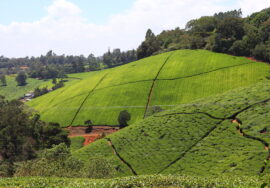Mount KENYA NATIONAL PARK
It takes up 276 square miles to be Mount Kenya National Park.
History
When the government decided to protect Mount Kenya and the forest around it in 1949, they made Mount Kenya National Park. The park was first named a forest reserve. In 1978, it was named a UNESCO Biosphere Reserve, and in 1997, it was named a UNESCO World Heritage Site along with the forest reserve that it was surrounded by. Mount Kenya National Park wasn’t just made for tourists; it was also made to protect the area’s beauty, wildlife, and, most importantly, its important role as a key water intake area.
Fees and permits to get in
Right now, it costs USD60 for an adult to enter Mount Kenya National Park and USD25 for a child younger than 12 years old. For 24 hours, this is still good.
When they are open
Every day, the gates to Mount Kenya National Park open at 6am and close at 6pm.
How to Get There
By Road
Mount Kenya National Park is 110 miles from Nairobi. It takes about four hours to drive there. You can take the Nyeri-Nanyuki road near Naro Moru or the Embu-Meru road from Chongoria. Mount Kenya National Park has six entrance gates. They are called Naro Moru, Kihari, Mawingu, Sirimon, Kamweti, and Chogoria.
By Air
It takes about an hour to fly from Wilson Airport in Nairobi to Nanyuki Airstrip. It takes 20 miles to get to the Sirimon Gate of Mount Kenya National Park.
Best Time to Visit
Climate and weather
During the dry, cooler winter months of July and August, Mount Kenya National Park has daily temperatures of about 60 F. In the summer months of January and February, the park gets up to 80 F. From the end of December to the end of February, the days are clear for people who want to climb Mount Kenya, but it will be warmer than in early June or late September. The short rains start in November, and the wet season lasts from March to May.
Staying away from crowds
It might be best to visit Mount Kenya National Park in June, September, and early October. This way, you can avoid tourists who want to climb Mount Kenya or go on trek from late June to the end of August, when it is cooler, and from January to February, when it is sunny and clear. When it comes to lodging, there will be more options and the park will have less action.
Good Value for Money
Most of the places to stay in and around Mount Kenya National Park are average and don’t cost too much. They’re good for people who want to see the park’s sights and for people who need to relax before or after their walk up Mount Kenya. Prices run from $100 to $400 per night for two people sharing, which includes breakfast.
Wildlife & Landscape
Wildlife that people like to see in Mount Kenya National Park
In Mount Kenya National Park, you can see the “Big Five”: the elephant, the rhino, the lion, the leopard, and the buffalo. You can see these popular animals roaming the park’s moors and woods. You might also see some rare animals, like the Giant Forest Hog, the Bongo, and the Tree Hyrax. Mount Kenya National Park is home to more than 130 kinds of birds.
The Ground
Mount Kenya National Park has a lot of different types of land, from thick montane forests to steep mountain sides topped with glaciers. The high elevation makes the plants Alpine, and the beautiful scenery is home to about a dozen plants that can only be found there. Mount Kenya National Park doesn’t have any real open areas like other parks in Kenya.
Safari Experiences
Game Drives
In Mount Kenya National Park, visitors can take a 4×4 drive through the park’s enclosed areas to look for wildlife in the woods and around the base of the beautiful Mount Kenya. Most of the things to do in this area are done on foot, so you won’t see many cars.
Safaris with a guide
In Mount Kenya National Park, you can go on a guided tour of its varied landscapes and look out for animals and plants, such as zebras, waterbuck, cows, elephants, and many kinds of birds. Watch out for the beautiful views from the park and forest reserve as well as the amazing slopes of Mount Kenya.
Lodges & Camps
There are many campsites and huts in Mount Kenya National Park, all of which are for hikers who want to climb Mount Kenya. A few more classic and semi-luxury places to stay are in and around the park, making stays more comfortable for people who come to the park or the area.
Mount Kenya National Park Lodging – Distance from park entrance
| Lodge or Hotel | Distance to park entrance (in miles) |
| Fairmont Mount Kenya National Park | 21 miles from the Sirimon Gate in a northeasterly direction |
| Anabas Adventure | 15 miles from the Chogoria Gate in an easterly direction |


